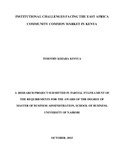| dc.description.abstract | Regional cooperation and integration can yield significant economic and political benefits and therefore there is need for economic cooperation in the region. Regional economic blocs have become the platform for international trade and commerce with each nation belonging to a particular regional organization. The centrality of regional blocs for nations seeking to harness the benefits of an increasingly globalized world and for purposes of meaningful engagement with the community of nations at the global level cannot be overemphasized. Most countries have followed a stage wise progression from economic cooperation edging towards deeper integration with the ultimate objective of full political integration. The common market is a step away from full economic integration of an economic and monetary union in the progression towards full political integration. The objective of the study was to establish the basis of the formation of East Africa Community Common Market and also to determine institutional challenges facing the East Africa Community Common Market in Kenya. The population of the study was the employees of the Ministry of Tourism and East Africa Community and the Ministry of Foreign Affairs and International Trade. A strong commitment towards integration is evinced given the fact the EAC has outpaced most other regional blocs in Africa in edging towards deeper integration. The results of the study show that as a result of the single market with free movement of people, services, labour and capital typifying the common market; several benefits accrue to member states as a result of joining the common market. The common market has led to increased trade activity within the Community, whereupon consumers in the member states have been treated to a variety of goods and services with competition serving to enhance quality of products. Businesses on the other hand have the benefit of access to a larger market and production base thus higher profits and lower costs with increased productive efficiency as they expand their operations. However, institutional challenges plague the common market to a large extent on account of coordinative failures inherent in the intergovernmental set up of the EAC. Challenges identified include: undeveloped infrastructure, economic dominance of some of the member states with economic benefits of increased productive advantage skewed in their favour; setbacks in regional integration efforts within EAC due to multiple memberships in other trade blocs by member states as well as delays in harmonizing tax regimes by EAC member states. Similarly non-tariff barriers were found to be a challenge, somewhat, in the EAC common market. Indeed despite mechanisms to deal with errant member states that enforce NTBS such mechanisms had only proven to be moderately effective. In conclusion the benefits of regional integration within the EACCM nonetheless greatly outweigh the constraints experienced whereupon the study suggests that the level of integration be fast tracked to a federation. The study also suggests that the level of private sector participation be enhanced in a bid towards deeper integration given their quintessential role as major players. It is also suggested that member states should refocus their commitment to full integration of the EAC by cutting back on multiple memberships in a multitude of other trading blocs | en_US |

